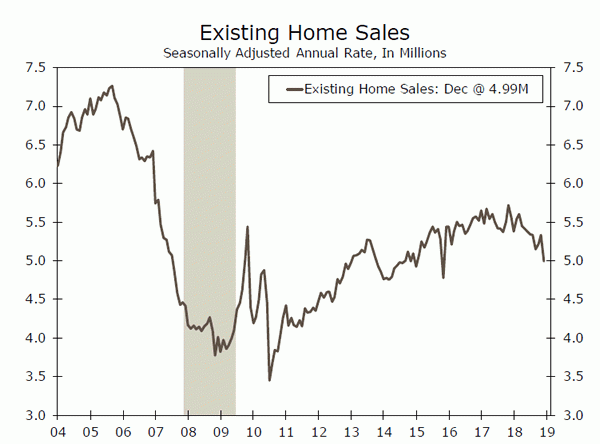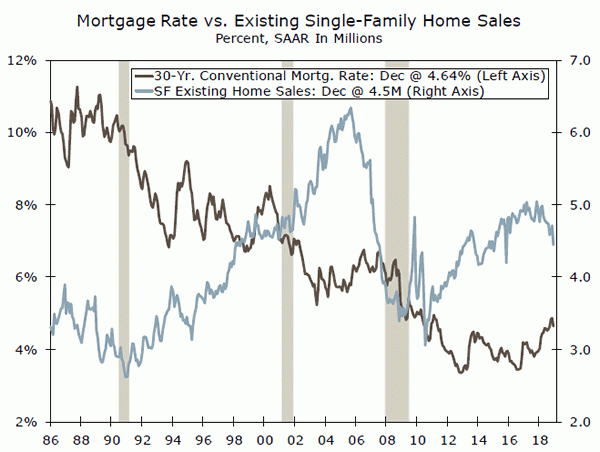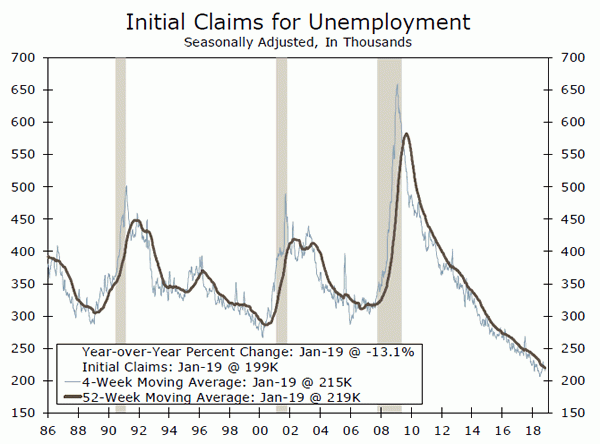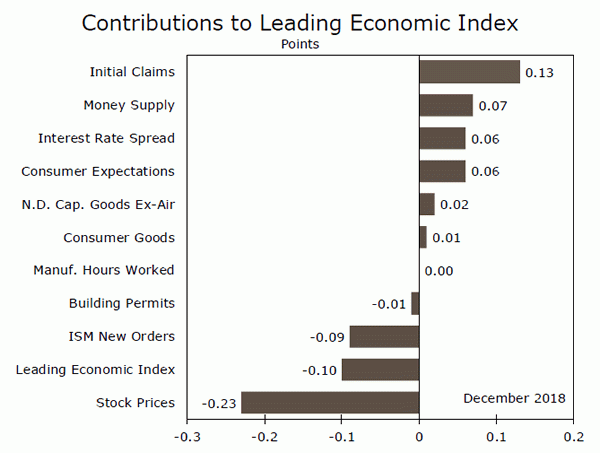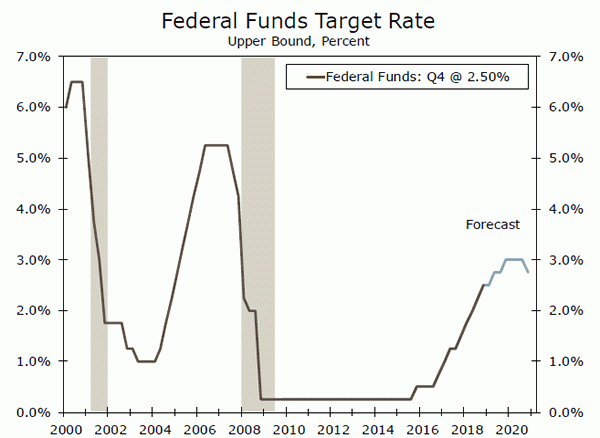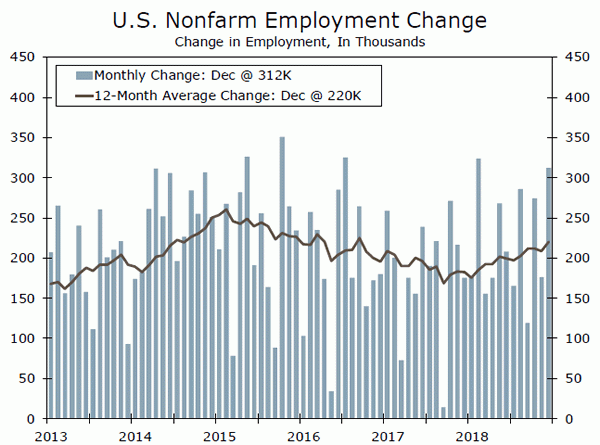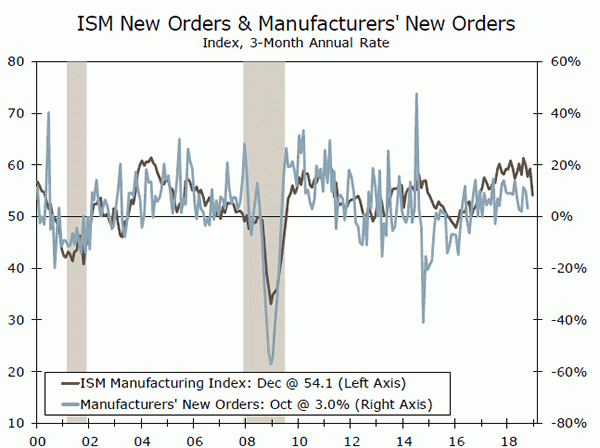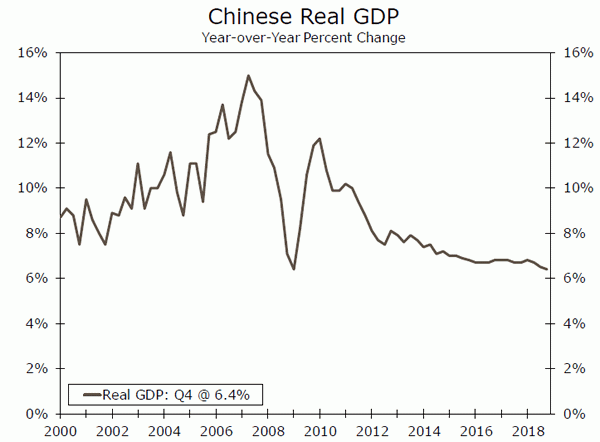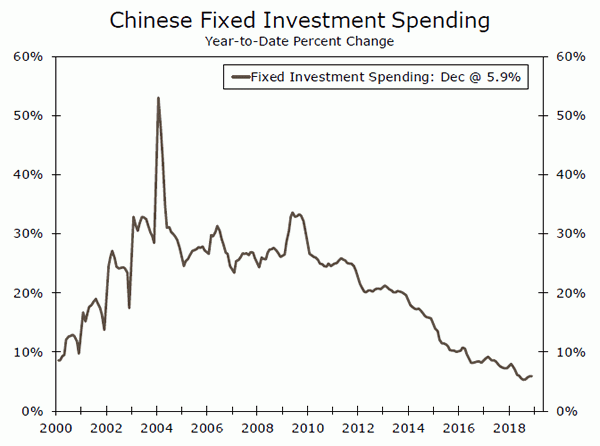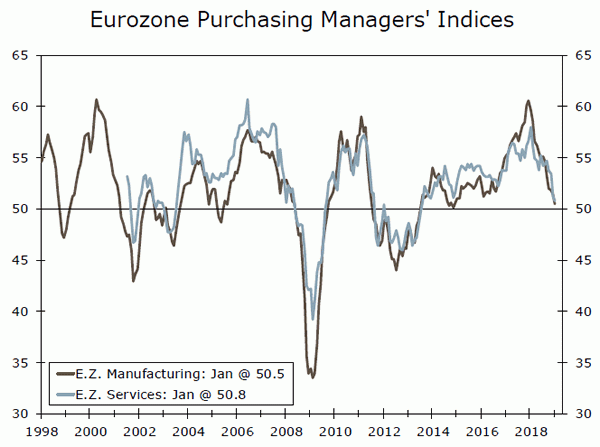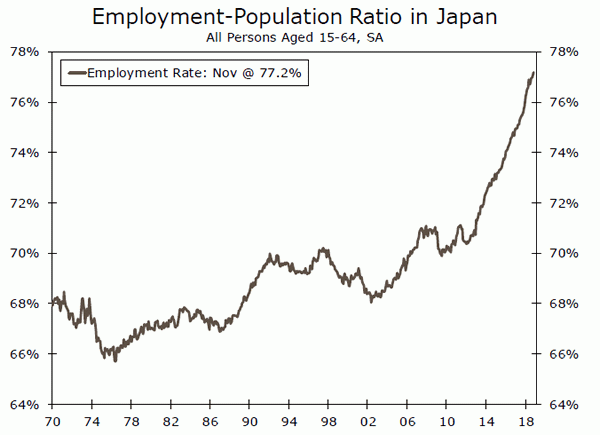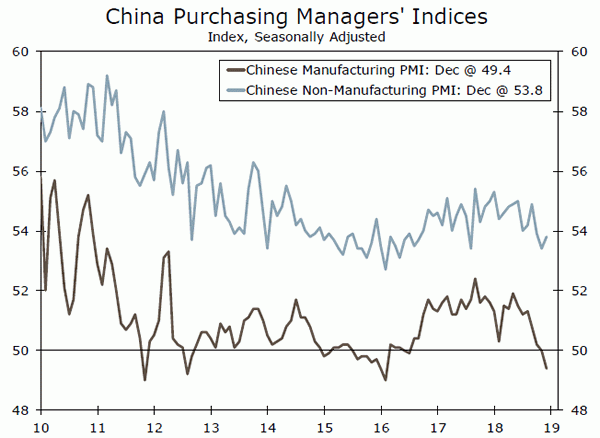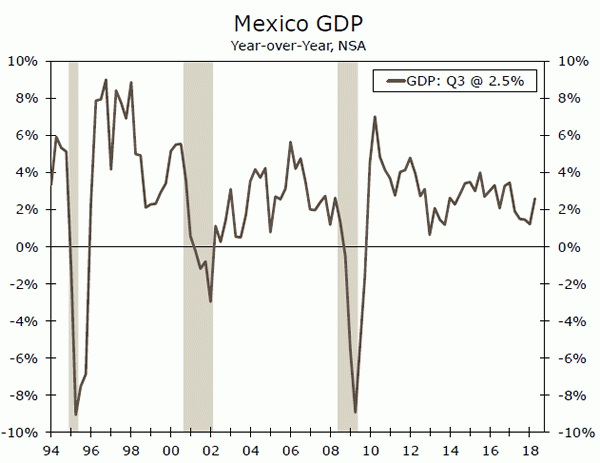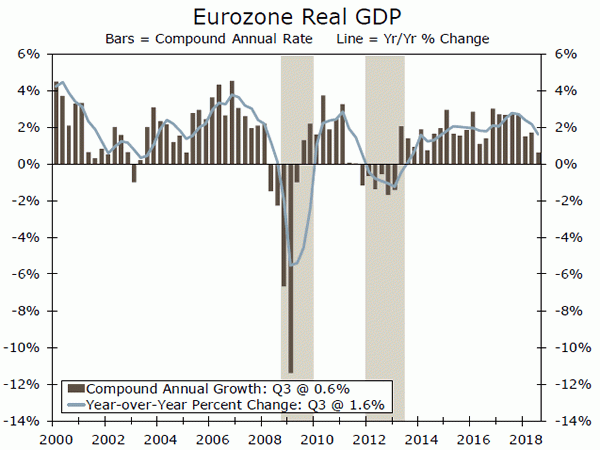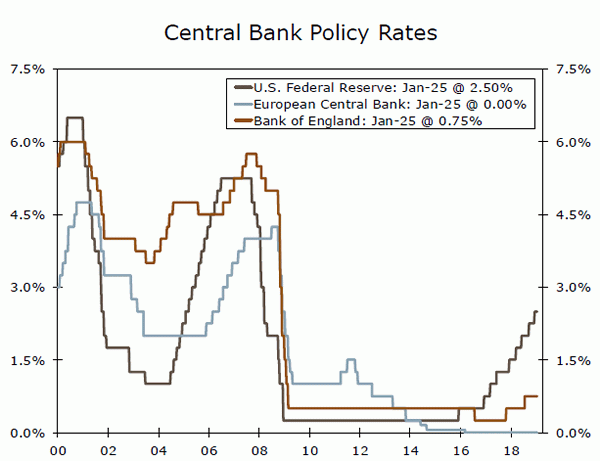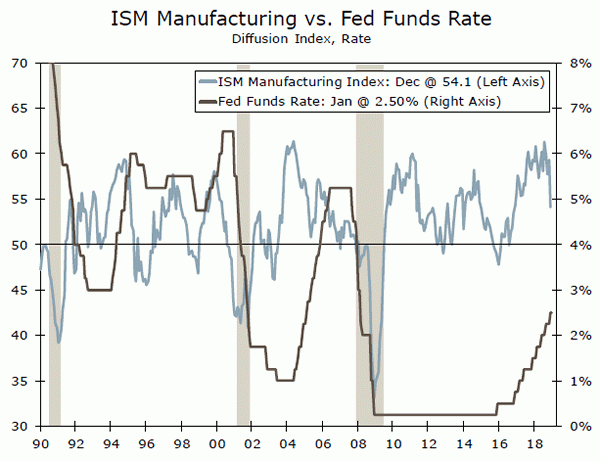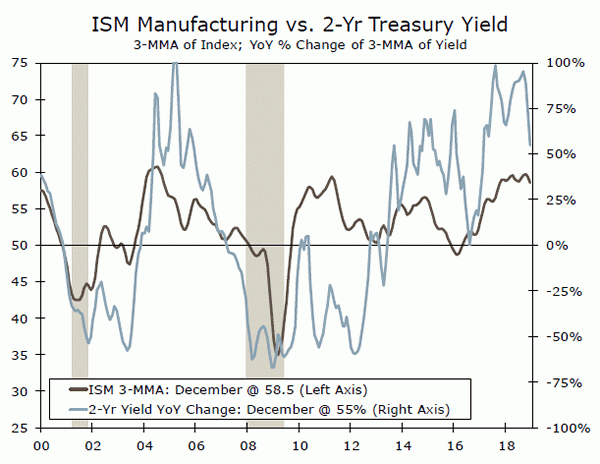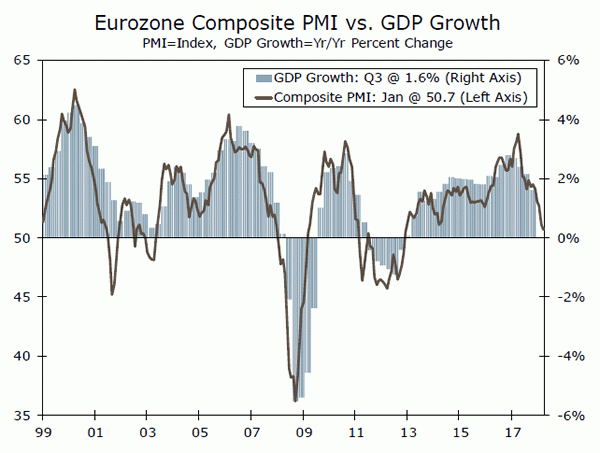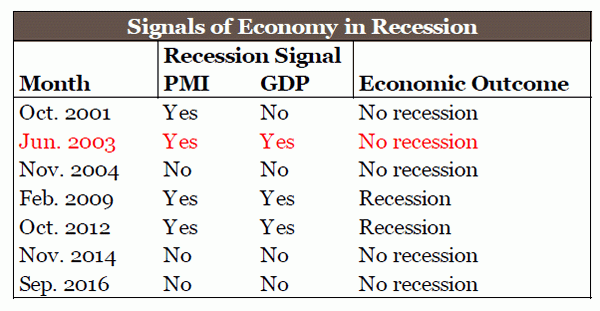Weekly Economic and Financial Commentary
U.S. Review
Home Sales End 2018 on a Low Note
- Data for durable goods orders and new home sales during the month of December were postponed as a result of the continued partial government shutdown.
- Existing home sales fell 6.4% to a 4.99 million-unit pace, the slowest since November 2015.
- Initial unemployment claims for the week ending January 19 fell to 199,000, the lowest level since 1969.
- A 0.1% decline registered in the December leading economic index (LEI) was mostly the result of a drag from financial market volatility.
Home Sales End 2018 on a Low Note
The partial federal government shutdown continued this week. The doors of many agencies that receive federal funding have now been closed for 35 days, the longest period in the nation’s history. As a consequence, reports for durable goods orders and new home sales during December were postponed.
While the Census Bureau was unable to provide data on new home sales, the National Association of Realtors (NAR) revealed that existing home sales faltered during December. Resales of singlefamily homes and co-ops/condos fell 6.4% to a 4.99 million-unit pace, the slowest since November 2015. The magnitude of the drop exceeded expectations, but a slowdown in sales was largely anticipated. Pending home sales, which measure contract signings and lead closings by four to eight weeks, weakened considerably in the second half of the year alongside noticeably higher mortgage rates.
December’s decline caps a year in which the housing market lost a great deal of momentum. Sales trended lower for much of the year, averaging a 5.34 million-unit pace in 2018, 3.6% lower than the average 5.53 million-unit pace posted in 2017.
That being said, December’s report offered a few bright spots that point to housing market conditions improving in 2019. Inventories of homes on the market grew 6.2% year over year during December, the fifth consecutive increase. Extremely low inventory levels have been a driving force behind the rapid home price appreciation and an impediment to overall sales. As inventory levels improve, home prices should continue to ease. The NAR reported that the median existing single-family home price moderated 2.9% year-over-year, the slowest rise since 2012.
More modest home price appreciation amid higher mortgage rates should help support a gradual improvement in home sales moving forward. While we expect mortgage rates to trend upward over the course of the year, rates on 30-year conventional loans fell in December, which led to a noticeable increase in mortgage applications in early January, further evidence that home buying activity is set to improve.
A solid labor market should also be supportive of housing and so far there has been little evidence of any weakening on the horizon. Initial unemployment claims for the week ending January 19 fell to 199,000, the lowest level since 1969. While initial claims had ticked slightly higher toward the end of 2018, claims have fallen in each week so far in January. Initial claims for federal civilian workers, which are reported separately and lag by one week, increased to 25,419, which was to be expected given the roughly 800,000 furloughed federal workers.
Meanwhile, the LEI continues to point to generally favorable economic conditions. The 0.1% decline registered in December was mostly the result of financial market volatility, which dragged down the overall index. A note of caution about reading too much into this report: due to the lack of new data arising from the shutdown, manufacturers’ new orders and building permits also had to be estimated by the Conference Board.
U.S. Outlook
FOMC Meeting • Wednesday
It is widely expected that the FOMC will leave its policy rate and balance sheet program unchanged at its January meeting. We expect the statement and Chair’s press conference—now held after every meeting—to reflect a more cautious and uncertain outlook, however.
The committee is likely to acknowledge signs of slowing growth based on “available data”—a nod to the fact that the partial government shutdown, an added source of uncertainty, has delayed the release of some key data (including the first look at Q4 GDP, originally due Wednesday as well). Given the more conservative outlook, the statement may also remove the notion that “further gradual increases” in the fed funds rate may be necessary. Overall, we believe the FOMC will remain constructive on the U.S. outlook, but the more dovish tone would be supportive of our expectations for the FOMC to pause further rate hikes until late in the second quarter.
Previous: 2.25-2.50% Wells Fargo: 2.25-2.50% Consensus: 2.25-2.50%
Employment • Friday
The exceptionally strong pace of hiring in December is unlikely to have persisted, and we expect hiring to slow below its recent trend. Government workers affected by the shutdown will still be counted as employed since back pay has already been approved, while the impact on contractors will probably be minimal since the survey was early in the shutdown. Yet other data, including job openings, hiring plans and PMI employment indexes, suggest more moderate hiring recently. Furloughed workers will be counted as unemployed, but after December’s jump and the release of annual adjustments to the household survey, we expect the jobless rate to tick down to 3.8%
Another strong print for payrolls and average hourly earnings would keep the FOMC on course to eventually raise rates twice more this year. A significant downside miss, however, would add support to the view that the FOMC needs to hold off on further rate increases longer than the committee currently anticipates.
Previous: 312,000 Wells Fargo: 155,000 Consensus: 160,000
ISM Manufacturing • Friday
The ISM index tumbled 5.2 points in December, but the drop left the index well within expansion territory at 54.1. The two-year low puts the ISM more in line with hard data on the factory sector, which had been pointing to softer factory sector performance for some months now.
With global growth slowing and continued uncertainty surrounding trade, the manufacturing environment has deteriorated over the past year, but we expect the ISM index will be little changed in January. The Markit and regional PMIs released thus far for January were, on balance, little changed from their December readings.
The ISM will take on increased importance given “hard” data on factory orders is not being published due to the shutdown. Another significant miss to the downside would suggest that the global environment is weighing more heavily on growth and support a more cautious policy stance by the FOMC.
Previous: 54.1 Wells Fargo: 54.0 Consensus: 54.3
Global Review
Economic Growth Cooling Off in Europe, China
- The Chinese economy grew 6.4% in Q4-2018 and 6.6% for the year, the slowest pace since 1990 as the country continues to battle structural and trade-related economic challenges.
- The European Central Bank (ECB) left monetary policy unchanged at its meeting this week, but acknowledged that the downside risks to growth are growing.
- The Bank of Japan (BoJ) also left monetary policy unchanged, while upgrading its growth forecasts and downgrading its inflation forecasts. Once again, reaching and sustaining the 2% inflation target seems a ways off.
Economic Growth Cooling Off in Europe, China
Chinese GDP for Q4-2018 kicked off the international data this week. The print was largely in line with consensus; real GDP growth was 6.4% year over year, down from 6.5% in Q3 (see chart on front page). For the year, the Chinese economy grew 6.6%, the slowest pace since 1990.
Chinese economic growth was slowing well before the trade dispute with the United States that accelerated in 2018. Workingage population growth has slowed significantly, investment spending growth has been on a secular decline for years (top chart), and the rapid pace of technological adaption has abated, as is customary for emerging markets at this point in their development. The escalation of trade tensions and the enactment of several rounds of tariffs has likely contributed to a sharper slowdown. Chinese policymakers have done their best to combat this slowdown via monetary and fiscal stimulus, but without a clean resolution to the trade situation, a more marked slowdown is likely in store in 2019. At present, our forecast for real GDP growth in China in 2019 is 6.2%.
In Europe, the European Central Bank (ECB) left monetary policy unchanged against a backdrop of economic growth that has weakened considerably over the past few quarters. Real GDP growth in Q4-2018 appears to have been just as weak as it was in Q3 (see the Global Outlook section and the Topic of the Week), and the first couple data points for Q1 have not been much better. The flash Purchasing Manager Indices for January was weaker and are now teetering on the edge between expansion and contraction (middle chart). Amid these signs, the ECB acknowledged that the economic risks in the Eurozone are tilted to the downside. Forward guidance from the ECB had already signaled that rates would be on hold through at least the summer, so for now the central bank seems content to monitor the data for additional signs of sustained weakness.
The Bank of Japan (BoJ) also met this past week and made no major changes to its still extraordinarily easy monetary policy regime. The central bank’s median growth projection actually ticked up modestly for fiscal 2019 and fiscal 2020, but its inflation forecasts came down for those two years, a phenomenon that has become all too familiar for BoJ policymakers. Once again, reaching and sustaining the 2% inflation target seems a ways off. Developments in overseas economies and the effects of the consumption tax hike scheduled to take place in October 2019 were two of the primary risks to economic activity identified by the BoJ.
One encouraging development in the Japanese economy has been the robust pickup in the employment-population ratio. Since the start of 2013, the employment-population ratio for all persons aged 15-64 has risen more than 6 percentage points (bottom chart). This has been especially true for females; the female employment rate for the same age cohort has risen more than 8 percentage points over the same period. For a country that has very well-documented demographic challenges, a larger segment of the population working is a welcome development, at least as it relates to things like fiscal sustainability and faster aggregate economic growth.
Global Outlook
Chinese PMIs • Wednesday/Saturday
Both the “official” and Caixin Purchasing Manager Indices for China are released next week and will offer an initial look at economic activity in China to start the year. As was discussed in the international review, economic growth continued to slow in China in Q4, and the “official” manufacturing PMI was 49.4 in December, its first close below 50 since July 2016. In that report, the new orders component also slid below 50, and new export orders continued to fall, declining to 46.6. The privately-produced Caixin Manufacturing PMI did not fare much better, also falling below 50 to 49.7, the lowest reading since May 2017.
Some stabilization in the PMIs would be encouraging, though the approaching Chinese New Year could cause some near-term noise in the data. A continued decline, however, would signal the downside risks are rising for China ahead of the key March 1 trade deadline with the United States.
Previous: 49.4 Consensus: 49.3 (Manufacturing)
Mexico GDP • Wednesday
Real GDP growth surprised to the upside in Mexico in Q3, rising 2.5% year-0ver-year, roughly the same pace as the previous two quarters. The fourth quarter in Mexico was a volatile one, with a depreciating peso, a decelerating economy according to the central bank’s projections and two rate hikes from monetary policymakers.
Lower oil prices will likely do little to help spur the investment needed to revitalize Mexican oil production, and the stagnation in U.S. vehicle sales represents another challenge to the Mexican economy. The trade uncertainty from NAFTA renegotiation has receded somewhat now that the USMCA has been signed, but the congresses of the countries must still approve the deal. With the U.S. government currently experiencing a historically long shutdown, the prospects for passage have probably not improved of late. We look for real GDP growth of 2.3% in Mexico in 2019 as fiscal stimulus provides a boost, before growth cools to 1.9% in 2020.
Previous: 2.5% Consensus: 2.0% (Year-over-Year)
Eurozone GDP • Thursday
Real GDP growth in the Eurozone clearly slowed in Q3-2018, but some of the slowdown was likely due to temporary factors, such as a one-off decline in auto purchases related to some regulatory changes. Since then, however, the data have continued to show signs of weakness. As mentioned in the Global Review, the PMIs have continued to soften, and industrial production in November posted the sharpest year-over-year decline since 2012. With economic growth in Q4 likely slowing further from the 1.6% year-over-year pace registered in Q3, any further deterioration as Q1-2019 data start to become available would be an ominous sign.
The first Eurozone CPI print of 2019 is also released next Friday. Though GDP growth has weakened, core inflation has held steady, hovering within +/- 0.1 percentage point of 1.0% every month since May. With growth weakening, any sign that core inflation is slowing would be yet another hurdle to the first rate hike from the ECB.
Previous: 0.2% Consensus: 0.2% (Quarter-over-Quarter, Not Annualized)
Point of View
Interest Rate Watch
Look to the ISM for Clues on the Fed
The financial markets are still priced as if the Fed has completed raising interest rates for this cycle and currently expect the next Fed move to be a cut in short-term rates early next year. Official pronouncements by Fed officials and the most recent dot plot of expectations for the federal funds rate for the next few years remain consistent with two more hikes this year before the Fed shifts directions amid slower growth and the upcoming presidential election in 2020. That remains our forecast as well, with hikes penciled in for June and December.
Next week’s FOMC meeting will probably not provide a definitive answer as to whether or not the Fed is finished hiking rates this cycle. It will likely reinforce the notion that it has become more patient and data dependent in setting policy than simply striving to return interest rates to a ‘neutral’ level. With data more scarce amid the government shutdown, the Fed will scrutinize what data is still being reported for important clues on what is being missed. Momentum has clearly slowed in recent weeks and many forecasters have scaled back their expectations for first quarter real GDP growth. The loss of momentum is most evident in the factory sector and was clearly picked up by the ISM manufacturing survey, which plummeted 5.2 points in December to 54.1, marking its largest one-month drop since May 2011. Most regional manufacturing indices also weakened that month. Data for January will be reported on Friday and will likely show a modest drop. Data from regional Fed surveys were mixed this past month.
The Fed has a long history of closely scrutinizing the ISM manufacturing survey. While the factory sector accounts for a fairly small proportion of GDP, it still provides the bulk of the cyclical impulse to the broader economy. The Fed has rarely raised the federal funds rate when the ISM index is declining sharply and has typically halted tightening cycles once the index fell below the key 50 break-even level. Another big drop in the ISM would likely cause the Fed to take a longer pause and if the index falls definitively below 50, it will likely remain on hold until the factory sector rebounds in a meaningful and sustainable way.
Credit Market Insights
A Watchful Eye on Consumer Credit
Since the FOMC’s last policy meeting in December, market implied probabilities of a rate hike this year have tumbled. This happened alongside a sharp sell-off in the stock market in December, and heighted fears that a recession was on the horizon. Even with a more recent dovish tone from the FOMC, worries of a downturn have not completely subsided, as the partial government shutdown has stretched into its fifth week and continues to cloud analysts’ visibility of economic developments.
After hiking rates 100 bps in 2018, it is widely expected that the FOMC will leave its policy rate unchanged at its meeting next week (see the U.S. Outlook section for more detail). Since the FOMC began raising rates in late 2015, the cost of carrying consumer debt has steadily increased. Interest rates on credit cards are now at their highest rate since 2000. With only minimal increases in income growth over this cycle, could the increased cost of debt become a concern among households?
Total household debt as a percent of GDP remains relatively low, while the household financial obligations ratio remains near lows not seen since the 1980s. This should allow households to withstand increased borrowing costs. Elevated saving rates should also add cushion to consumer finances. But, with our assumption that the FOMC will eventually resume its gradual pace of tightening with two more rate hikes this year, the cost of debt will likely continue to rise, and could pressure consumers.
Topic of the Week
Is the Eurozone Economy Close to Recession?
The recent slowdown in Eurozone economic growth has sparked fears that the bloc may be approaching, or already in, a recession. Forecasting recessions is a notoriously difficult task, and even defining what marks a recession is not always straightforward. In a recent special report, we identify a couple simple rules of thumb that may allow readers to monitor the economic data for signs of an imminent recession in the Eurozone. While some recent indicator readings are worrying, we do not believe the data at present suggest a Eurozone recession is either imminent or inevitable.
In our view, GDP growth would need to range between 0.1% to 0.2% (or slower) per quarter for three or more quarters AND the composite PMI would have to remain at or below the 51.0 level for several months before we would become seriously concerned that the Eurozone is either imminently approaching, or in, economic recession. The historical results of using this approach are illustrated in the table to the right.
What then are the implications for the current episode? Like ECB President Draghi, we do not (yet) believe these important economic indicators are signaling an approaching Eurozone recession. GDP growth has averaged 0.33% per quarter over the past three quarters, a pace that has been consistent with the Eurozone avoiding recession in the past (Q3-2004 to Q1-2005 and Q2-2001 to Q1-2002). The January PMI, however, dipped just below 51 to 50.7, though this was admittedly the preliminary “flash” estimate.
Pulling it all together, it is clear to us that the Eurozone economy has slowed materially over the past year. The data do not yet indicate to us that a recession is inevitable or imminent, but both the level readings and the directional trends suggest heightened monitoring of the data is warranted. If Q4-2018 real GDP growth is especially weak next week, a Q1-2019 rebound will become even more important to stave off a recession and keep the ECB on track to tighten rather than ease as its next move.




